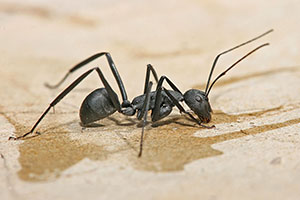General Info
- Carpenter ants gnaw into wood to make or expand their colonies, not to eat wood
- These ants have large and powerful jaws and will bite if disturbed
- Carpenter ants are found all over the U.S. but are particularly troublesome in the Pacific Northwest
Where They Nest
- Carpenter ants commonly build indoor colonies in wall voids, attics, and water-damaged or rotting structural wood
- Common outdoor colonies are found in sheds, firewood, deck woods, tree trunks, gutters, and soffits
- Look for ants going in and out of a hole with small bits of sawdust around the opening – this is a sign that the colony is nearby
What They Want From You
When seen indoors, they are looking for:
- Food in the form of insects which is their main diet
- Moisture found in and around the sink, shower, leaky pipes, and spills – these are ideal locations for building new, indoor colonies
Carpenter ants can enter the home:
- Via a tree branch or utility lines that are touching part of the home
- Through cracks in the foundation, gaps, or openings around windows and doors
- On firewood brought inside to burn
Why They’re A Problem
- The presence of carpenter ants can be a sign of water or moisture problems in your roof, gutters, porch, deck, floors, or walls
- Large colonies that are left untreated can be as destructive to homes as termites
Tips & Tricks
- Search for leaks in and around areas where you see these ants. These leaks/moist areas will need to be repaired/corrected
- Remove limbs/shrubs that touch the house, particularly the roof – ants use these contact points to gain access
- Remove stumps and dying trees within 50 feet of the house/garage – these are perfect spots for new colonies to start
- Store firewood off the bare ground and away from the house
- Consider using inorganic mulches (stone, gravels) in areas where you have had problems with ants, or where ground moisture is a re-occurring problem
- Inspect older trees carefully for signs of outdoor colonies

